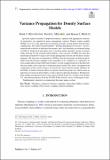Files in this item
Variance propagation for density surface models
Item metadata
| dc.contributor.author | Bravington, Mark V. | |
| dc.contributor.author | Miller, David Lawrence | |
| dc.contributor.author | Hedley, Sharon Louise | |
| dc.date.accessioned | 2021-03-05T17:30:20Z | |
| dc.date.available | 2021-03-05T17:30:20Z | |
| dc.date.issued | 2021-02-23 | |
| dc.identifier | 272862363 | |
| dc.identifier | b2dab681-8595-473f-821a-0f798448b04d | |
| dc.identifier | 000621066800001 | |
| dc.identifier | 85101412506 | |
| dc.identifier.citation | Bravington , M V , Miller , D L & Hedley , S L 2021 , ' Variance propagation for density surface models ' , Journal of Agricultural, Biological and Environmental Statistics , vol. First Online . https://doi.org/10.1007/s13253-021-00438-2 | en |
| dc.identifier.issn | 1085-7117 | |
| dc.identifier.uri | https://hdl.handle.net/10023/21564 | |
| dc.description | Data from the SCANS-II project were supported by the EU LIFE Nature programme (project LIFE04NAT/GB/000245) and governments of range states: Belgium, Denmark, France, Germany, Ireland, Netherlands, Norway, Poland, Portugal, Spain, Sweden, and UK. This work was funded by OPNAV N45 and the SURTASS LFA Settlement Agreement, and being managed by the US Navy’s Living Marine Resources program under Contract No. N39430-17-C-1982, US Navy, Chief of Naval Operations (Code N45), grant number N00244-10-1-0057 and the International Whaling Commission. | en |
| dc.description.abstract | Spatially explicit estimates of population density, together with appropriate estimates of uncertainty, are required in many management contexts. Density surface models (DSMs) are a two-stage approach for estimating spatially varying density from distance sampling data. First, detection probabilities—perhaps depending on covariates—are estimated based on details of individual encounters; next, local densities are estimated using a GAM, by fitting local encounter rates to location and/or spatially varying covariates while allowing for the estimated detectabilities. One criticism of DSMs has been that uncertainty from the two stages is not usually propagated correctly into the final variance estimates. We show how to reformulate a DSM so that the uncertainty in detection probability from the distance sampling stage (regardless of its complexity) is captured as an extra random effect in the GAM stage. In effect, we refit an approximation to the detection function model at the same time as fitting the spatial model. This allows straightforward computation of the overall variance via exactly the same software already needed to fit the GAM. A further extension allows for spatial variation in group size, which can be an important covariate for detectability as well as directly affecting abundance. We illustrate these models using point transect survey data of Island Scrub-Jays on Santa Cruz Island, CA, and harbour porpoise from the SCANS-II line transect survey of European waters. Supplementary materials accompanying this paper appear on-line. | |
| dc.format.extent | 18 | |
| dc.format.extent | 9881920 | |
| dc.language.iso | eng | |
| dc.relation.ispartof | Journal of Agricultural, Biological and Environmental Statistics | en |
| dc.subject | Abundance estimation | en |
| dc.subject | Distance sampling | en |
| dc.subject | Generalized additive models | en |
| dc.subject | Line transect sampling | en |
| dc.subject | Point transect sampling | en |
| dc.subject | Spatial modelling | en |
| dc.subject | QA Mathematics | en |
| dc.subject | QH301 Biology | en |
| dc.subject | DAS | en |
| dc.subject.lcc | QA | en |
| dc.subject.lcc | QH301 | en |
| dc.title | Variance propagation for density surface models | en |
| dc.type | Journal article | en |
| dc.contributor.sponsor | Office of Naval Research | en |
| dc.contributor.institution | University of St Andrews. School of Mathematics and Statistics | en |
| dc.contributor.institution | University of St Andrews. Centre for Research into Ecological & Environmental Modelling | en |
| dc.identifier.doi | 10.1007/s13253-021-00438-2 | |
| dc.description.status | Peer reviewed | en |
| dc.identifier.grantnumber | N00244-10-1-0057 | en |
This item appears in the following Collection(s)
Items in the St Andrews Research Repository are protected by copyright, with all rights reserved, unless otherwise indicated.

